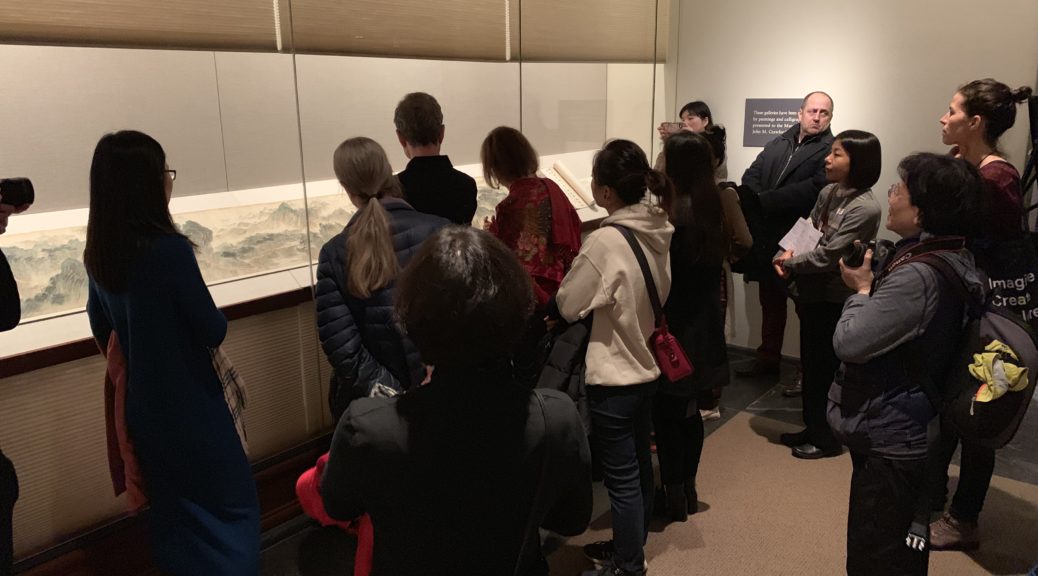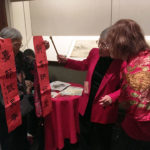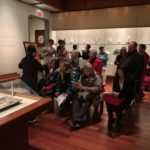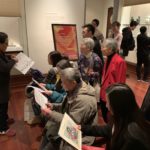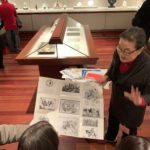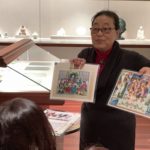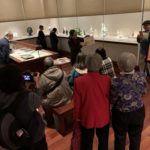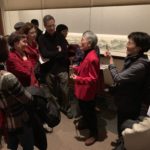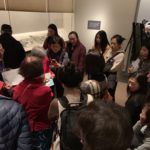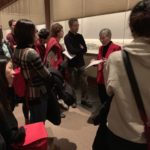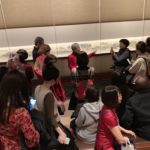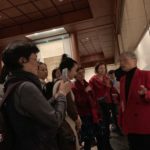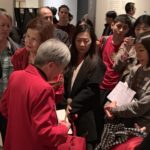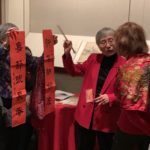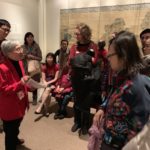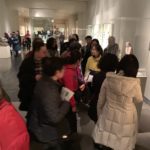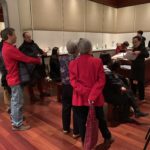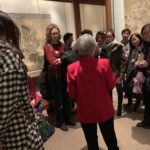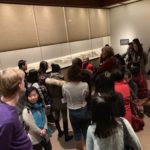大都會博物館每年以十二生肖為主題來慶祝亞洲新年傳統,豬年迎新活動於2月9日星期六上午11點到下午5點,畫廊中由藝術家參與指導各年齡階層進行表演、互動活動以及藝術工作坊。三位新紐約客學員很榮幸首次受邀解析館內亞洲藝術收藏品,以英語和華語分享們的觀點和故事。
Lunar New Year Festival: Year of the Pig at the Metropolitan Museum.
On 2/9/2019 ( Saturday ), from 11 am to 5 pm, we sponsored the annual celebration of the Asian tradition, the Chinese horoscope of twelve zodiac animals, with performances, interactive exercises in the galleries as well as workshops directed by artists befitting all visitors. Three New New Yorkers artists from the Queens Museum explicated /shared their perspectives and stories about the artworks from the Met’s collection both in English and Mandarin.
明 黑漆嵌螺鈿八仙賀壽圖托盤 Tray with Daoist figures
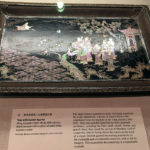
- Period: Ming dynasty (1368–1644)
- Date:16th century
- Culture: China
- Medium: Black lacquer with mother-of-pearl inlay; basketry sides
- Dimensions: H. 1 3/4 in. (4.4 cm); W. 18 3/8 (46.7 cm); D. 11 5/8 (29.5)
- Classification: Lacquer
https://www.metmuseum.org/art/collection/search/73222
蔣傳葵(Chuankui Jiang) 導覽222畫廊漆器藝術:「明黑漆嵌螺鈿八仙賀壽圖托盤」,首先介紹漆器的作法及藝術,和為何選擇以八仙的題材作為此次導覽的重點,現場即興來了段「京劇小放牛」表演,再延伸八仙在道教和文化中的歷史意義與價值,並舉例了一些庶民文化中常用的歇後語。
Chuankui Jiang introduced “Tray with Daoist Figures” in the gallery 222. She discussed Chinese lacquer techniques and also introduced the Eight Immortals stories. She shared with visitors what she has learned from this artwork and also exhibited as solo show: “ The cattleman “ in Beijing opera styles. Additionally, she also presented several idioms arose from Eight Immortals legend.
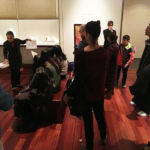
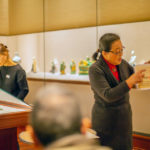
東漢 玉握豬 Pig in Recumbent Position
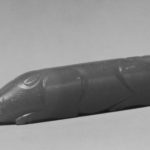
- Period: Eastern Han dynasty (25–220AD). Approximately 1700 to 1900 years ago
- Date:1st–2nd century
- Culture: China
- Medium:Jade (nephrite)
- Dimensions: H. 1 1/8 in. (2.9 cm); L. 4 1/2 in. (11.4 cm)
- Classification: Jade
https://www.metmuseum.org/art/collection/search/44396
蘇彩菁於207畫廊介紹「玉握豬」,豬在中國古時是財富的象徵,「玉握豬」是西漢時期達官貴人,過逝時握於手中用玉雕的豬,藉著玉握豬,期望來生仍享受榮華富貴。並以此藏品延伸至十二生肖其意義及對中華文化的影響。聽眾來自四面八方,遠至義大利、墨西哥、日本及北京等,亦有美國其他州及紐約本地人,大家對十二生肖的故事聽得津津有味,爭相問及自己的生肖,及所屬生肖的運勢及個性,最引發聽眾興趣的是與那個生肖最相配,其中有對夫婦恰巧生肖相配,高興極了!
Tsae Jiaug Su introduced a miniature carving of a pig in the gallery 207 which is a symbol of a plethora of wealth in ancient China. Sculptures made of jade or soapstone were often placed in the center of palms of deceased ancestors for a wish to sustain eternal wealth in the afterlife.
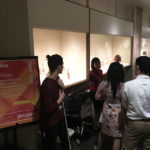
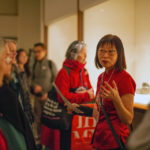
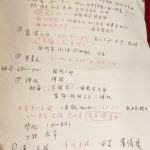
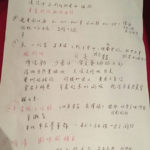
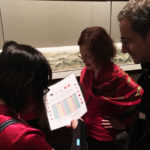 Pigs possess cardinal roles in Chinese daily life; they are one of the three sacrificing animals offered to the spiritual ancestors at the major memorial ceremonies; the Chinese character “home (jia)” was composed of the emblem of a pig housed under a roof. It symbolizes the dwelling of a corpulent belly pig in the house. The pig character in Oracle is the simplified graphic representation of a pig. Pigs are docile and fertile animals. Ancestors assumed that housed pigs assured the supply of food. Therefore, copious pigs have become a symbol of settled life. The visitors were fascinated by the connotation of their Zodiacs. A couple was so pleased after knowing that they have an impeccable match on Chinese Zodiac
Pigs possess cardinal roles in Chinese daily life; they are one of the three sacrificing animals offered to the spiritual ancestors at the major memorial ceremonies; the Chinese character “home (jia)” was composed of the emblem of a pig housed under a roof. It symbolizes the dwelling of a corpulent belly pig in the house. The pig character in Oracle is the simplified graphic representation of a pig. Pigs are docile and fertile animals. Ancestors assumed that housed pigs assured the supply of food. Therefore, copious pigs have become a symbol of settled life. The visitors were fascinated by the connotation of their Zodiacs. A couple was so pleased after knowing that they have an impeccable match on Chinese Zodiac
明/清 黃向堅 萬里尋親圖 卷
Searching for My Parents Artist: Huang Xiangjian (Chinese, 1609–1673)
謝濟民 簡介屏、掛軸、手卷之別,引領大家欣賞210展廳的三幅畫作:清袁江九「成宮圖屏」、清蘇仁山「深山樓台圖軸」、明清時期黃向堅的「萬里尋親圖手卷」。
Olivia, Chi-Ming Hsieh introduced the handscroll style artwork “The Searching for My Parents” crafted by Huang Xiangjian. She explained the dissimilarities between 3 styles of Chinese paintings in gallery 210.
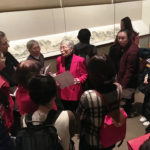
- Period: Qing dynasty (1644–1911)
- Date: dated 1656
- Culture: China
- Medium: Handscroll; ink and color on silk
- Dimensions:Image: 14 3/8 in. × 18 ft. 2 in. (36.5 × 553.7 cm)
Overall with mounting: 14 3/4 in. × 27 ft. 1 in. (37.5 × 825.5 cm) - Classification: Paintings
https://www.metmuseum.org/art/collection/search/73652
「萬里尋親圖手卷」,採用寫實主義,描繪黔西雲貴的群山孤峰,粗獷中不乏細膩,渾厚中略帶古雅,特別指出山水畫多抒發情感,寄託情思,述說流傳在蘇州的萬里尋親故事。中國書畫史上不可多得的精品之一,最可貴的是畫家融入親身經歷和情感,為後人留下了一段感人至深的故事。當時為畫家贏得『黃孝子』的美名,用盡盤纏的黃向堅借此開館授徒,維持生計。她介紹並發放大都會博物館製作的『孝子』『忠孝傳家』的紅色紙片,且展示後蜀孟昶桃符對聯『新年納餘慶』『嘉節號長春』,祝福觀眾新年快樂,旅途平安,闔家團聚。
The handscroll paintings is a unique skill originated from Chinese painters. This format is very suitable to landscape paintings that very frequently includes streams, brooks or rivers. Huang utilized this type of painting to depict the scenery of his journey. Visitors were enchanted with the Chinese landscape paintings and attempted to highlight the contrast between the gigantic mountains and tiny humans emphasizing the infinitesimal significance of mankind alongside the spectacular nature. Handscroll painting is viewed from right to left. In old days, scholars view each other’s works of art as gathering. They liberated the scroll slowly from the right to the left and often became astonished at the end by the tremendous atmosphere and craftsmanship. She also gave visitors concise comprehension on the elements of traditional Chinese painting “The Four Treasures of the Study”, including brush pens, ink sticks, ink slabs, and rice papers. The four calligraphic tools were used by intellectuals in a daily manner. In the end, she showed visitors spring couplets and explained the meanings behind them. She also wished everybody have a happy lunar new year.
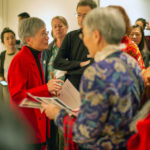
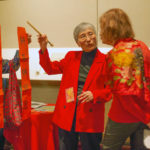
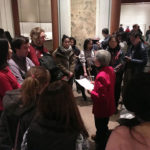
當天館內有許多紐約當地和世界各地來的觀眾,三位新紐約客學員盡其所能的導覽,在準備過程中,不斷看書,上網搜尋資料,充實自己,收獲頗豐。在講解時聽衆反應熱烈,現場有許多反饋和互動,大家都覺得對宣掦中華文化盡了一份心意,是最開心、特別又有意義的農曆新年。
This was a particularly important event with global attendance. Three New New Yorkers were well-prepared and had very descent feedbacks and interactions from visitors. They were proud of themselves and also so delighted having this opportunity of sharing the culture diversity at the MET.
(影像來源: 林瑩芳、朱晏締 Images by Ying-Fang Hsu, Judy Chu, Yenti) & New New Yorkers.

